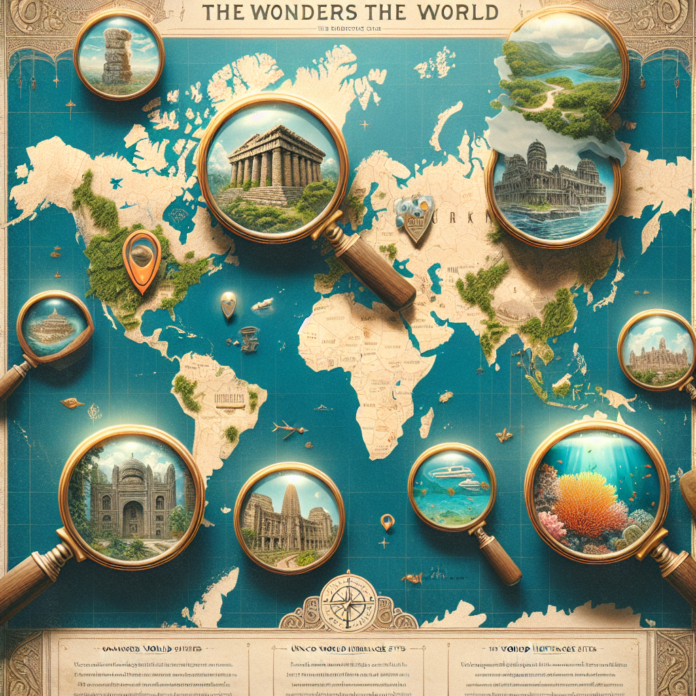[ad_1]
UNESCO World Heritage Sites are locations that have been recognized by the United Nations Educational, Scientific and Cultural Organization (UNESCO) for their outstanding cultural or natural value. These sites are considered important to all of humanity and are protected and preserved for future generations to enjoy.
The Great Wall of China
The Great Wall of China is one of the most famous UNESCO World Heritage Sites and is a must-see for anyone visiting China. Stretching over 13,000 miles, the Great Wall was built over centuries to protect China from invasions by various nomadic groups. Today, visitors can hike along various sections of the wall and marvel at the incredible engineering feat.
Machu Picchu, Peru
Located high in the Andes Mountains of Peru, Machu Picchu is an ancient Incan city that was built in the 15th century. The site is known for its stunning terraced fields, intricate stone walls, and panoramic views of the surrounding mountains. It is one of the most visited archaeological sites in the world and a true marvel of human ingenuity.
The Pyramids of Egypt
The Pyramids of Egypt are perhaps the most iconic of all UNESCO World Heritage Sites. Built as tombs for the pharaohs, the pyramids are a testament to the ancient Egyptians’ engineering skills and architectural prowess. The Great Pyramid of Giza is the largest and most famous of the pyramids and is a must-see for anyone interested in ancient history.
The Colosseum, Rome
The Colosseum in Rome is one of the most well-preserved ancient Roman amphitheaters in the world and is a UNESCO World Heritage Site. Built in the 1st century AD, the Colosseum could hold up to 80,000 spectators and was used for gladiatorial contests and other public events. Today, visitors can explore the ruins of this iconic structure and learn about its fascinating history.
Angkor Wat, Cambodia
Angkor Wat is a temple complex in Cambodia that was built in the 12th century by the Khmer Empire. The site is one of the largest religious monuments in the world and is known for its intricate carvings, imposing stone structures, and beautiful surroundings. Angkor Wat is a UNESCO World Heritage Site and a symbol of Cambodia’s rich cultural heritage.
Stonehenge, England
Stonehenge is a prehistoric monument in England that consists of a ring of standing stones. The site is believed to have been constructed around 3000 BC and is shrouded in mystery and speculation. Stonehenge is a UNESCO World Heritage Site and is a popular destination for visitors interested in ancient history and archaeology.
Chichen Itza, Mexico
Chichen Itza is an ancient Mayan city in Mexico that was built between the 9th and 12th centuries. The site is known for its impressive pyramids, temples, and ball courts, as well as its intricate carvings and sculptures. Chichen Itza is a UNESCO World Heritage Site and a testament to the advanced civilization of the Maya.
Taj Mahal, India
The Taj Mahal is a stunning white marble mausoleum in India that was built in the 17th century by the Mughal emperor Shah Jahan in memory of his wife. The Taj Mahal is considered one of the most beautiful buildings in the world and is a UNESCO World Heritage Site. Visitors can admire the intricate marble carvings, lush gardens, and serene reflection pools that surround the monument.
FAQs
What are UNESCO World Heritage Sites?
UNESCO World Heritage Sites are locations that have been recognized by UNESCO for their outstanding cultural or natural value. These sites are considered important to all of humanity and are protected and preserved for future generations to enjoy.
How many UNESCO World Heritage Sites are there?
As of 2021, there are over 1,100 UNESCO World Heritage Sites located in 167 countries. These sites include landmarks, buildings, cities, and natural areas that are deemed to be of significant cultural or natural importance.
How are UNESCO World Heritage Sites chosen?
UNESCO World Heritage Sites are chosen based on strict criteria that consider the site’s outstanding universal value, authenticity, and integrity. The site must also have adequate protection and management plans in place to ensure its preservation for future generations.
Can anyone visit UNESCO World Heritage Sites?
Most UNESCO World Heritage Sites are open to the public for visitors to explore and appreciate. However, some sites may have restrictions on access or require permits for entry. It is important for visitors to respect the rules and regulations of each site to help preserve its cultural or natural value.
How can I support UNESCO World Heritage Sites?
There are several ways to support UNESCO World Heritage Sites, including visiting the sites and following the rules and regulations, making donations to preservation efforts, volunteering with conservation organizations, and spreading awareness about the importance of protecting these cultural and natural treasures.
What are some lesser-known UNESCO World Heritage Sites?
While the Great Wall of China, Machu Picchu, and the Pyramids of Egypt are some of the most famous UNESCO World Heritage Sites, there are many lesser-known sites that are equally deserving of recognition. Some examples include the Historic Centre of Bukhara in Uzbekistan, the Archaeological Site of Volubilis in Morocco, and the Sacred City of Caral-Supe in Peru.
[ad_2]


